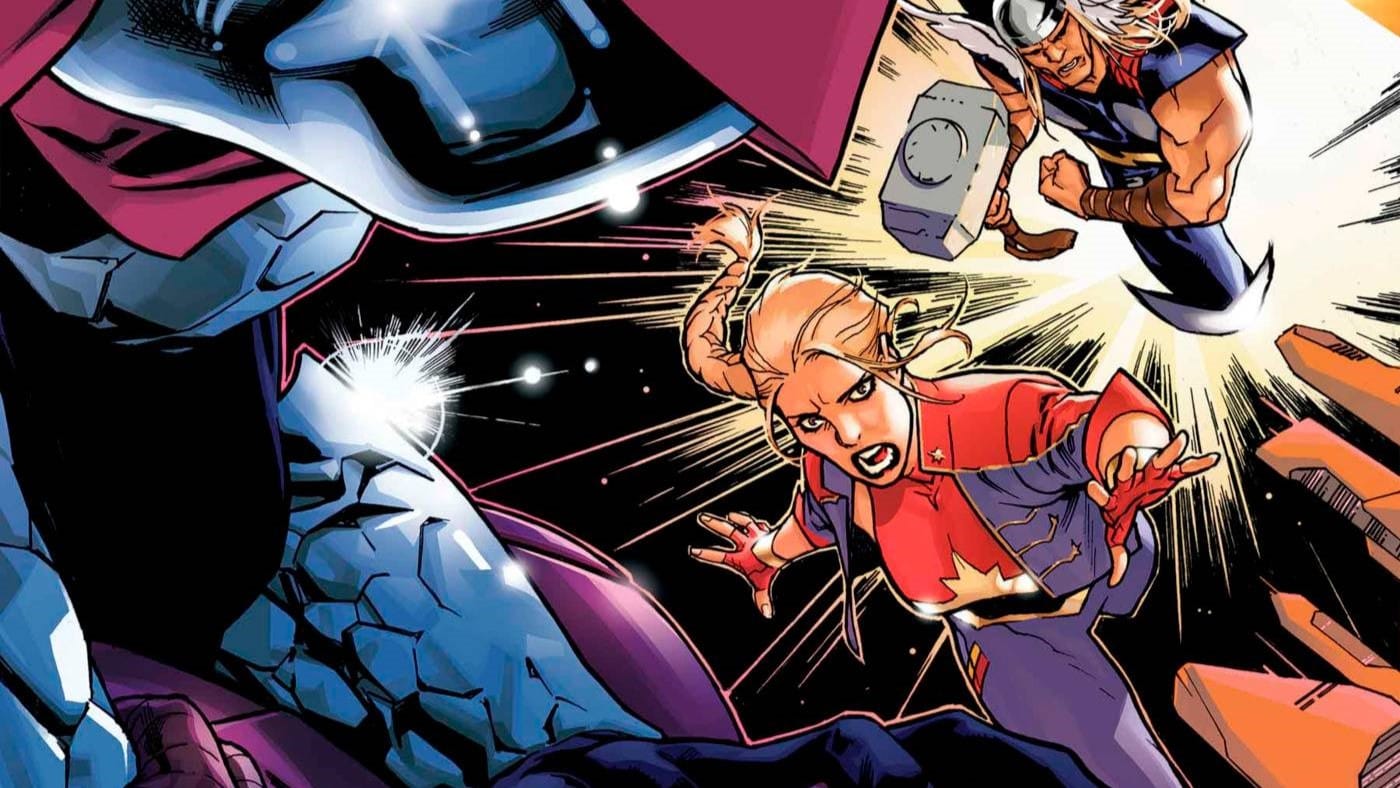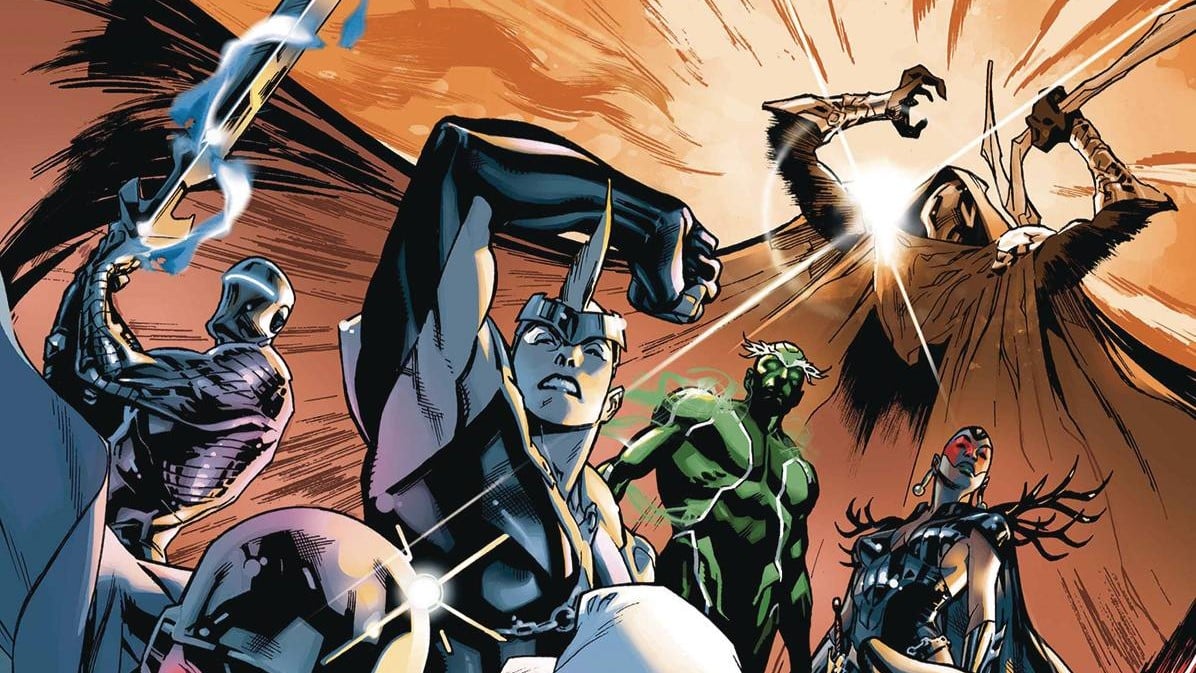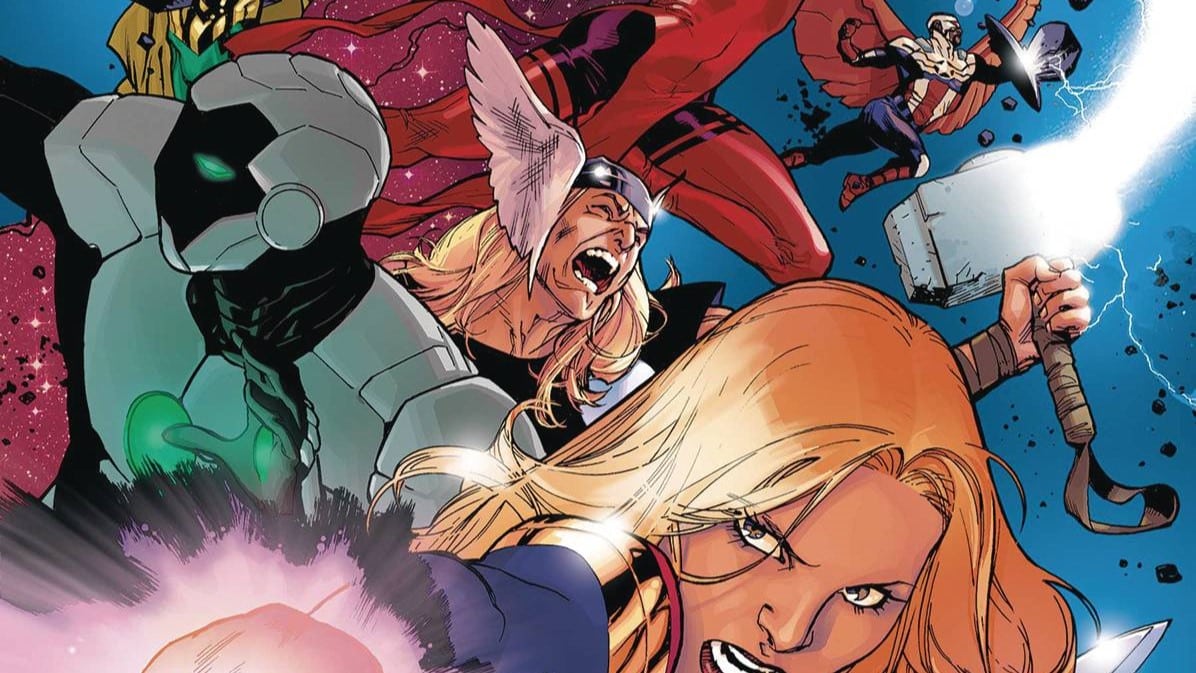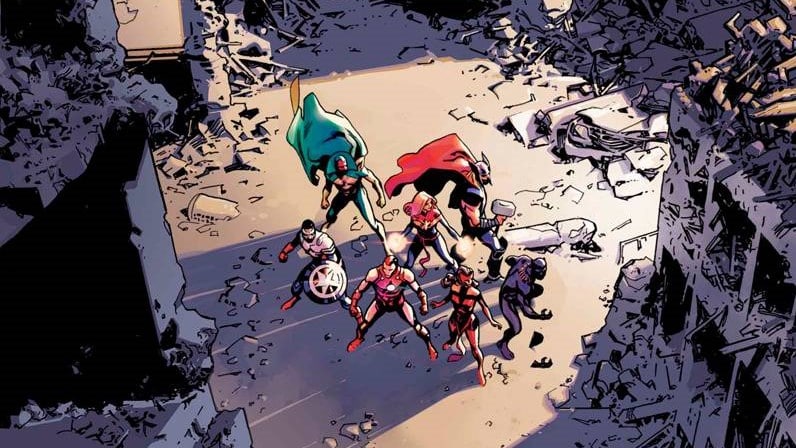It’s an all out brawl between the Avengers and the Twilight Court! Gods vs. gods, kings vs. kings, icons against icons. Need we say more? The masterminds behind this certainly aren’t. The Avengers #9 is written by Jed MacKay, drawn by Francisco Mortarino, colored by Federico Blee, and lettered by VC’s Cory Petit, with art in #10 done by C.F. Villa.
There are a lot of things I love about comics about superhero teams. The interpersonal dynamics, the soap operas, the sheer number of subplots and tangents any one team member can drag the others into…but sometimes, I just really really like to watch ‘em fight. Avengers #9 gives me exactly what I want in that department — it’s a big ol’ brawl, and I had fun!
The issue after that…much less fun.
Also less fun is that we’re missing Anna this week. 🙁
First Impressions (That’s a Punching Pun)

Before we begin in Avengers #9, we are given a quick flashback to the moments before this arc began — Captain Marvel talking to the Impossible City, as it reaffirms how happy it is to work with the Avengers — right before they all fall asleep.
I felt like this moment was entirely skippable, but there is an interesting takeaway — MacKay has Captain America and the Black Panther as balances for each other. The latter is willing to make the hard choices, while the former does what’s “right”. It shines a little light on how much they seemed to rub each other the wrong way, back in Avengers #4 – a scene that baffled me at the time, but that makes a little more sense in context. I’m not entirely convinced that it’s the best choice for the characters, but it does help to know what the book’s going for with them.
I find it more interesting from the perspective of their roles — the Icon and the King. It’s up to the King to make the hard choices, while it’s the Icon’s job to inspire.
Cutting to the battle that takes up the bulk of the issue, what’s fun about Lancelot is her obsession with blades — especially as her counterpart, Captain America, is just a man with a shield. I’ve found that in video games, a shield is an extremely satisfying weapon (for a given value of “weapon”) to play with — it lets you wait your enemy out, and pick just the right moment to strike back, as Sam deftly shows us this issue. I imagine it’s especially frustrating for a fast-moving fighter like Lancelot is!
The other weapon vs. weapon scene we get is when god faces god — Thor up against Galehaut. Thor’s already been up against one faux-god this run (Idol Alabaster, I miss you!), so his blood’s already burning — but despite being a god who summons lightning, he’s in for a rude shock when Galehaut pulls out the hammer of the Fearless!
For those of our readers who may have skipped the event, Marvel’s Fear Itself involved hammers of great power being given to those worthy of creating fear, sent out by the Norse God of Fear himself in a whole thing that ended in Thor’s death. Sure, he got better, but it’s perhaps easy to see why he’s not so happy to see one of those hammers in someone’s hands again.
Throughout the fight, all of the Avengers find themselves…uniquely matched. It’s not a perfect line-up of role vs. role. Sure, Iron Man and Bedivere have an engineer-off, trying to appeal to each other’s reason and appreciating each others’ work before returning to fisticuffs, but Wanda, the Witch, chooses the King, Arthur, as her opponent…an opponent who just so happens to be wearing the armor of Chthon, a perfect foil for her own powers (with the caveat that the precise nature of her powers changes wildly from writer to writer — we’re just going to roll with it).
The art looks great. It’s shiny, it’s exciting, it’s lively. Federico Blee, especially, is giving us gorgeous coloring that sets each scene apart. However, the flow of the battle itself leaves a bit to be desired. We see the hits, and the cool, confrontational poses — but are given very little visually in terms of how one moment flows into another. The clearest example of this is Cap vs. Lancelot — we see him throw the shield at her three times, in quick succession, but not how he manages to catch it after each bounce and throw it again before Lancelot can react. It’s a shame, because given his wings, his maneuverability could have been quite something to see.
Most of the action, then, boils down to cool moments, with the dialogue doing a lot of the heavy lifting towards letting us know how well things are going at any given moment.
The Ol’ Switcheroo

Despite the fact that the Vision and the Scarlet Witch were able to hold the team off pretty much on their own, the Avengers as a whole aren’t doing so well against the Twilight Court. They’re too evenly matched by their opponents — which means it’s time for the classic team move of switching dance partners.
I’ve got…mixed feelings about how this goes down. On the one hand, I enjoy the light cleverness of how the Avengers get their wins. Vibranium claws shred through advanced engineering. A shield waits out an untouchable man. Chthonic magic trumps Fearless Hammer, and lightning apparently gets past Mordred’s defenses in a way Vision’s fists and laser eyes could not.
Parsifal, especially, amuses me. With his whole undefeatable-while-his-cause-is-just schtick, there’s only one real way to defeat him: semantics. We saw it with Kang, and we see it here with Tony, as he pops out of his suit to give Parsifal a severely unfair fight – and we’ll likely keep seeing it.
On the other hand, I feel like semantic wins are a lot of what we’re getting in this run. A pithy piece of dialog that explains why one person wins makes superhero battles feel like little more than silly riddles — it’s unsatisfying in a way that I can’t quite put my finger on.
What is satisfying is the Vision ending the battle in one quick move — phasing his hand right through Arthur’s armor, around his heart. It feels both clever and tactically sound — it is the most direct way to have won that fight, and the cold, ruthless simplicity of it feels like such a particularly Vision moment of badassery.
Cryptic Conversations

Avengers #10 is where things take a turn towards something Anna and I have been frustrated with for a while.
Most of it is taken up by Myrddin and Kang’s conversation, with the action becoming a low stakes afterthought. We’re told very specifically that the fight the Avengers are in is simply misdirection; that the real important stuff is happening behind the scenes.
Typically, this is something that helps set the stakes — to impress upon the reader that things are in motion that are much, much bigger than our protagonists understand. To set the stage for what’s to come, hinting at it without giving too much away, to get readers excited for whatever it is that comes next.
This issue fails to do that on two fronts. First, it attempts to create a sense of gravitas of which Jed MacKay has so far proved incapable of providing. Second…setting up what comes next has taken up the majority of this book for ten issues now (plus one Timeless special), and rather than getting me excited, at this point I’m just…tired.
I’ve enjoyed Jed MacKay as a writer. Taskmaster was wonderful. Moon Knight’s gotten me more invested in the character than I’ve ever been. The Black Cat series might be the best Felicia Hardy’s ever been written. But those are all street level heroes, with a sharp, wry, and sometimes light-heartedly cynical view of the ridiculous world they’re in. In The Avengers, MacKay is attempting to play things straight — to play up the grandeur, and the stakes.
He does this by throwing around a lot of fancy titles – The Impossible City. The Missing Moment. The Tribulation Event. The Grail. He has so far done very little in the way of explaining what any of it means. On top of that, he undercuts the grandness with small little jokes, with little moments of cleverness, that work brilliantly for street-level heroes taking on challenges bigger than themselves — but don’t quite work in a comic that’s set its ambitions as high as his Avengers has.
In this comic, Myrddin essentially re-establishes the stakes for those who haven’t read Timeless. Which is fair enough, I doubt many people did — but that’s all that happens. Before we get any real information, before Kang can reveal what he knows to the Avengers, Myrddin wipes the Conqueror’s mind — meaning he now knows just as much about what’s going on as we do.
Which is bupkis.
This issue’s other big scene doesn’t give us a lot to go on, either — though it does make the start of this arc mean a lot more in hindsight. The large, world-ending threat the Avengers were fighting was, indeed, a nightmare — but one that was Nightmare’s nightmare. If I wasn’t so frustrated with this book, I’d be touched, and fascinated, by the concept of Nightmare being such a proud, petty being that the only way he can share what he’s afraid of is by trapping heroes in the exact same nightmare themselves.
But still. We know a world-ending threat is coming, thanks to this scene, but we still know so little about it. What makes it so dangerous, aside from its size (because the Avengers have fought bigger)? What makes it so invulnerable, what does it want, where does it come from? What about this threat makes it so different from any of the other threats the Avengers have faced before?
We know nothing.
We get an artist change in Avengers #10 with C.F. Villa, who I really enjoyed here. His artwork is a little looser, a little rougher around the edges, but he does a delightful job of animating a character whose face is entirely hidden by a mask. Myrddin’s body language is impressively expressive — and Villa’s Kang is too, despite spending the entire scene bedridden and pinned down.
The action is, like I said before, an afterthought, but Villa — teamed with Frederico Blee on colors — brings so much expression to the page that I would love to see a longer action sequence with the team. The action is just misdirection, though. The Avengers are a small part of their own comic. They’re dwarfed by threats of what’s to come, without knowing anything about it — they’re unwitting pawns in a larger game.
There’s not a lot of fun in reading a comic book about pawns — not when the book is more focused on the larger game at play, and especially not when that book refuses to actually tell us anything about that game. This book’s pacing is maddening. Ten issues in, and it still feels like we’re in the prologue stage. In monthly comic book terms, that’s too long for so little.
This iteration of the The Avengers started ten months ago. If you want to get technical and include Timeless, this story began well over a year ago.
I am tired of waiting for this comic to start.
Avengers Assortments
- One of the Twilight Court can turn into a giant! That is awesome! That is fun!
- Thor is good at the Strong God Brooding, but the Scarlet Witch’s dramatic poses are second to none.
- I want Myrddin to become a little more popular, simply because his costume is one I very much want to cosplay.
- We never saw the Twilight Court actually end the fight. How did it end? Did they disappear? Did they call a time out? Did they say “Hey, what’s that over there?!” and then vanish? I want to know!
- For a time traveler, Kang is appallingly bad at the art of patience.
- [Ed. Note]: Isn’t it kinda weird that we have the Twilight Court here at the same time as the unrelated Avengers Twilight miniseries? Apparently, the word “twilight” is having a moment.






